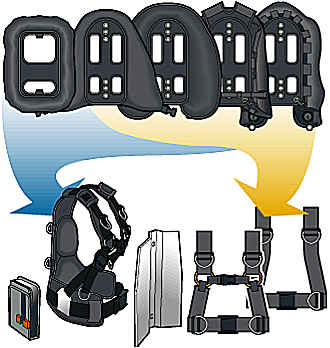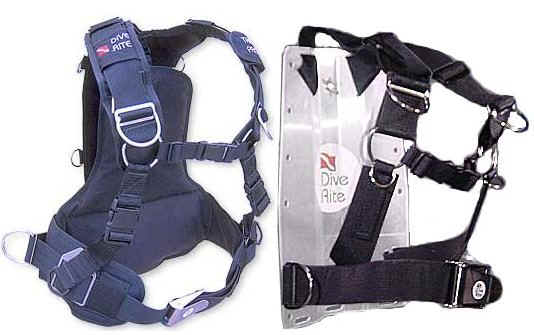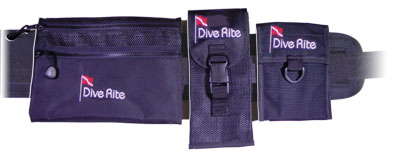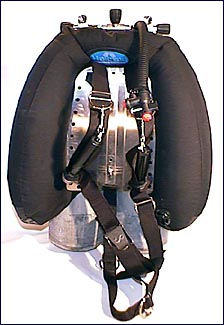Buoyancy Compensator
The Buoyancy Compensator or BC is thought of primarily as a flotation device, and for warm-water divers with not much more than a single tank and reg, this is pretty much all it needs to be. However, for cold-water divers, the BC serves another and equally if not more important function: it is the base around which all the rest of your gear is assembled. For cold-water diving, a BC may be called upon to support multiple tanks, weights, gauges, bags, and myriad accessories - much more equipment than a tropical diver would ever carry. And not all BC designs are equally good at this.
BCs come in essentially two styles: the jacket style, where the entire BC is sewn into something like an inflatable vest, and the "tech" style, which consists of a web harness to which a back-mounted air bladder is attached for floatation. One thing that most beginners do not realize is that if you planned your dive and weighting correctly, you should be carrying very little air in your BC during your dive; especially true if you use a drysuit. Therefore, many of the manufacturer's big selling points of "interconnected three-dimensional air cells" and the like are more specious marketing hype than useful features, and the old inverted-U back bladder ( clearly descended from an automobile inner tube ) will work just as well as the much more complex and expensive designs, and sometimes better.
Bad
The popular jacket-style BC still dominates the market - you probably got certified in one. This design is supposed to have the advantage of floating an incapacitated diver ( or a panicked student ) face-up at the surface. This is simply not so - every jacket-style BC that I have ever used floats you face down in the water, especially if used with a buoyant aluminum tank. If you were unconscious, you would drown in one of these as surely as you would drown in any other type of BC, especially in rough seas. In fact, the inadequate lift that most jacket-style BCs provide makes them even worse than other designs in this regard. A BC is simply not a life preserver.

Another fallacy about jacket-style BCs is that they are more comfortable than harnesses. Because they are designed for fashion rather than function, their load-carrying characteristics are very poor: the weight of the tank is transmitted as tension over the shoulders and straight down the front of the BC, where there is nothing to resist it. Therefore, the tank sags when out of the water, pulling the whole thing out of shape and probably cutting into you uncomfortably under the arms. A stretchy Velcro cummerbund that does little to secure anything at the waist rounds out the list of structural deficiencies. With a Jersey-sized load of double tanks and other gear, the basically poor fit and design of one of these BCs is really evident. Both on land and in the water the whole arrangement is just loose and sloppy, sliding around with every motion. Also, these BCs generally lack a useful number of D-rings and other attachment points to hang accessories from, and leave little room for customization.
Yet another flaw in almost all jacket style BCs is that they have just a single cam band to secure the tank. This is inadequate; dual tank bands provide a much more secure mounting for the heaviest item you are likely to be carrying. No tank will ever slip from a two-banded BC, whereas it will readily fall out of a single-banded BC if the strap is not tight enough, or the buckle pops off. Given that the tank cam band is a standard and quite inexpensive part, manufacturers really have no excuse for not providing all of their products with two instead of one. Maybe it's not fashionable.
Jacket-style BCs are junk. If you already own one and like it, good for you. But if you are in the market for a new BC, don't waste your money. And ladies - beware of so-called Women's BC's. I've never spoken to anyone who used one that thought highly of it.
Good
Fortunately, the simple old harness-style designs of the past are making a resurgence as the much-improved modern "Tech" BC. To get an idea of what these are like, just look at a good camping backpack. The shoulder straps originate close behind the neck, run down the chest with a cross-strap between, then around the sides to reattach to the pack at the rear. With a solid belt around the waist, this structure is capable of supporting enormous weight securely and comfortably. Add plenty of D-rings in strategic locations, and optionally a crotch strap ( you never know when you might get upside-down ) and you have an excellent base upon which to build the rest of your equipment. The uncluttered chest area gives the user a feeling of freedom, and also allows for a drysuit inflator, while a generous air cell at the back provides ample lift at the surface. And ladies - the relatively narrow shoulder straps may be easily routed around sensitive areas.

Here is an illustration of one such system from DiveRite. At the top is a selection of interchangeable back-mounted air bladders, ranging from a small travel-size to a huge cave diving size. Below that is a selection of harnesses, including a soft-pack and a hard metal backplate that mates with a choice of two strap designs. The small item at the lower left is an optional weight pouch. Even in this illustration, the enormous number of adjustments and attachment points is obvious. Not shown are a wide range of small accessory pockets and other add-ons that are available. Almost anything that is made to fit on a 2" nylon web weight belt can be adapted to one of these harnesses.


With a completely modular system like this, you can select those components that suit you, and build a custom BC system that will fit you and serve you far better than any fixed jacket-style BC. Even with well over 100 pounds attached, a harness like this is rock solid, with all the weight hanging comfortably from the shoulders. In the water, it is likewise very snug and secure, and the many D-rings mean you will never run out of places to hang things.
The soft-pack shown works quite well with single tanks, and is easily adapted to double tanks, with either permanent or temporary bands. It is extremely comfortable and versatile, and packs up small and light for traveling. The steel backplate and harness shown above are really only suited for double tanks with permanent bands. Adapters exist for single tanks, but these are clumsy at best, and expensive. One advantage of the steel backplate is that it can reduce your weighting requirements, by virtue of its own weight. However, for all these reasons, a steel backplate is not too good for traveling. Backplates are also available in plastic and aluminum.

Many BC manuals and dive shops will tell you that your BC should be brought in for "maintenance" once a year just like your regulator. Whether you choose to pay for this or just check it over yourself at the beginning of the season is up to you.
DIR

The only allowable BC in the DIR system is a hard backplate woven-through with a single long piece of nylon webbing in a manner known as "Hogarthian." You can look that up in Google for more details. The design is driven mainly by fear of entanglement hazards and failure points, although in truth these fears are mostly imaginary in open water.
DIR divers will harp on all the stitching in a soft pack harness, claiming that this adds weakness and failure points. In fact, nylon stitching is very strong - more than enough for its purpose. Likewise, the shoulder buckles which make the rig much easier to get on and off and adjust are quite solid. My TransPac has hundreds of dives on it and shows no signs of failure.
DIR adherents claim that every D-ring represents an entanglement hazard, as do compression straps on buoyancy wings, weight and storage pockets, and other accessories. This is simply unrealistic - these items seldom snag on anything, although an unrestrained buoyancy wing fluttering in the current is more likely to get sliced open on a sharp piece of wreck than a neatly bungied one. My TransPac has hundreds of dives on it and has never snagged a D-ring on anything.
By itself, a pure Hogarthian rig is inadequate for Northeast diving, but it can easily be built-upon with additional D-rings, buckles, some padding, bungies, etc, to become serviceable. Note that the Hogarthian rig still retains all of the drawbacks of a hard plate system, as described above.
On Multiple D-Rings
While leafing through the then brand-new PADI/DSAT technical diving materials, I was amazed at some of their conclusions. In particular, they state that selecting among multiple BC D-rings is task loading, therefore bad. While this is exactly in line with cave diving theory, it is not fit well into the real world of cold-water diving. From experience, I will tell you that working entirely by touch, with cold-numbed hands inside 6mm mitts, whichever D-ring you find first is exactly the one you wanted. The more D-rings you have, the sooner you'll find one when you need it. This is not some theory, this is experience.
